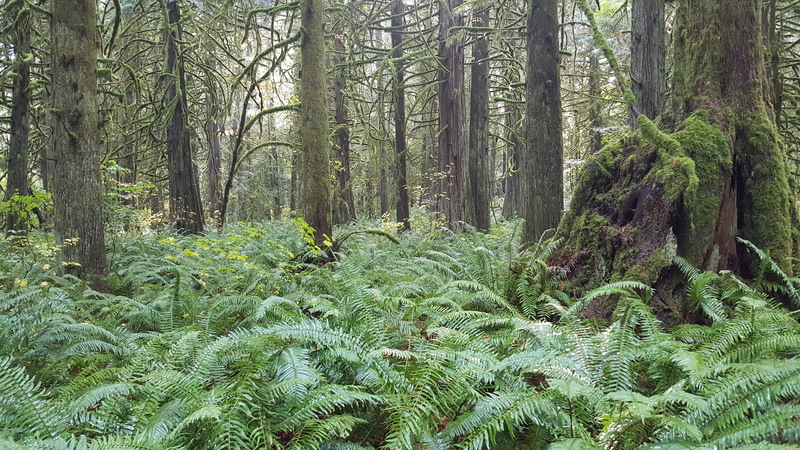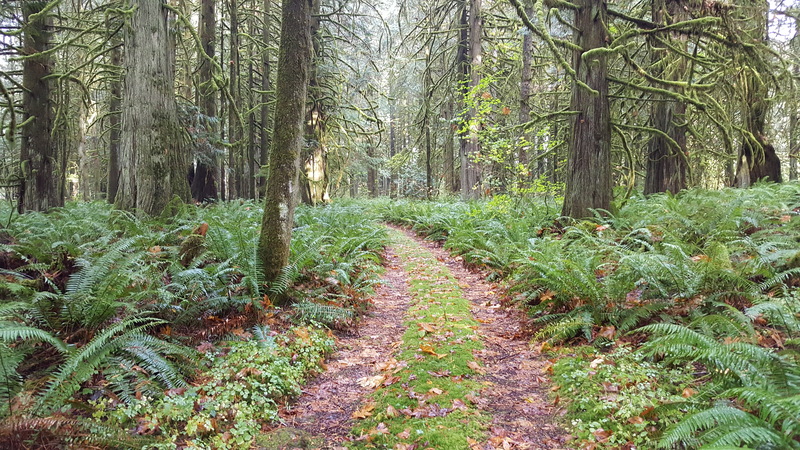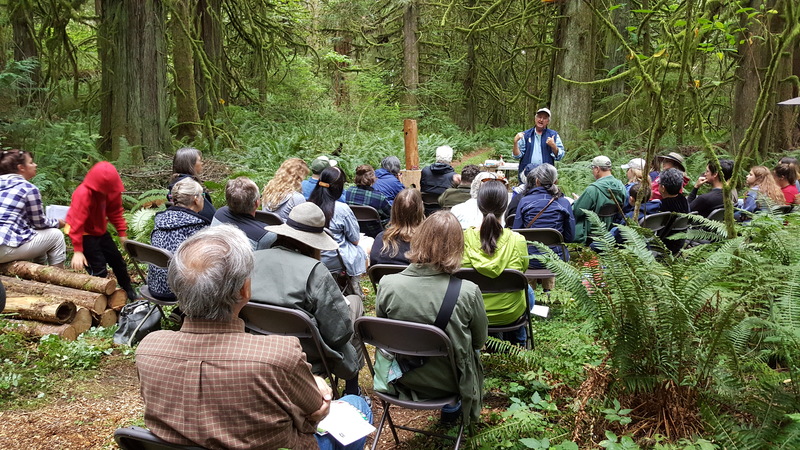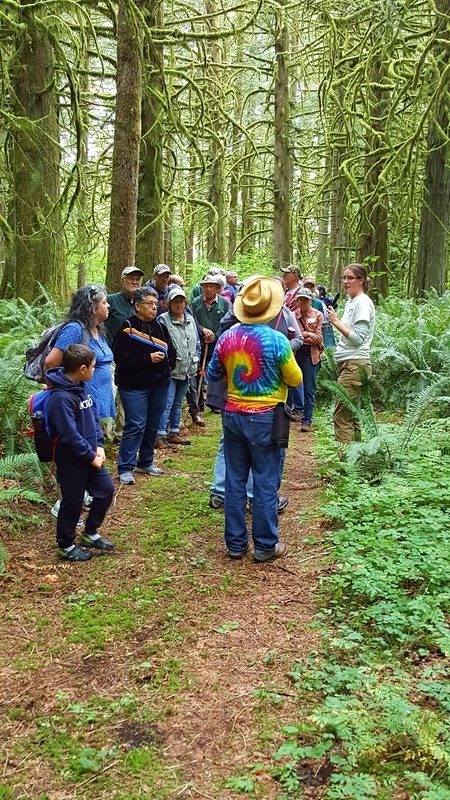Estate Planning Advice from A Family Forest

Planning what happens to your land after you pass on is a critical part of good forest stewardship. If you don’t plan to sell your land or pass it on to another family member, you’ll need to figure out not just how it will be managed in the future, but who will manage it. That involves a lot of decisions, and likely a lot of outside help. But even if you do plan to leave the land to your kids or other family members, don’t assume that transition will happen smoothly on its own.
Without a plan in place – preferably outlined in a legal document – your vision for your land could collapse amid family dynamics, financial considerations, and disinterested heirs.
Unhappy transitions
NNRG interviewed Andy and his daughter Andrea, who steward a 122-acre family forest in Washington, to learn about their experiences with estate planning. Andy, who inherited a portion of his parents’ property, under somewhat contentious circumstances, warns of the pitfalls of leaving it entirely up to the next generation to decide what happens to the land. Andrea discusses how her family’s recent estate planning process has set a clear guiding path for how she and her siblings will care for the land in the future. Since our conversation touched on sensitive family topics, we’re keeping their forest name and surnames anonymous.
“The property was originally purchased by my parents in 1954,” says Andy. “Dad had just gotten out of the military, and they wanted to move out to the country and raise a family on a farm. They found this property, 264 acres of farm and forest, and bought it for $15,000 (in 1954 dollars).”
Andy and his five siblings all grew up on the farm, but Andy says he probably developed the strongest ties to the land. “I spent a lot of time in the woods as a kid, it was not only a playground for me but a place to go when I wanted to be alone.”

Immediately after graduating from high school, Andy went into the Airforce and while in the service got married. During his military service, he was stationed in Arizona and ended up getting a job in Mesa after his enlistment was over and lived there for an additional 7 years. Andy’s’ other brothers and sisters moved off the property except for his oldest brother who graduated from college and then came back to live on the farm and build a home there.
Andy lived in Arizona for 11 years but never really liked the southwest heat and lack of trees in the area of the state he was in. So, in 1984, Andy packed up his family and belongings and returned to the moist forests and cool sea breezes of western Washington.
He wanted to build a house on a beautiful, forested part of the land, but learned since his name wasn’t listed as an owner on the property title – only his parents were – he couldn’t get a mortgage to build a house. His only solution was to buy a mobile home and put it on the property. “Then my younger brother moved back to the farm after getting out of the Navy and had the same issue. He couldn’t get a mortgage because he didn’t own the underlying property and ended up getting a mobile home just as I had done.”
“In 1992 my parents finally decided to subdivide the property and transfer the titles to me and my siblings,” says Andy and this is when things got messy. At that time there were 4 families living on the farm, Andy, his parents and two brothers. Andy’s parents put him in charge of how the property was going to be divided with the condition that all the siblings had to agree with the final result.
Andy believes that leaving the decision entirely up to him and his siblings caused a good portion of the difficulties and hard feelings that followed.
“Before they subdivided, my parents logged a portion of the forest to fund their retirement. So, the property ended up with clearcut areas, young forest, older forest, fields and an area we called the swamp where a stream had been dammed by beavers. The variability in value of different parts of the land – and the fact that it had to be divided between six kids with different visions for its future – made coming to an agreement very, very difficult.”
“Some liked the fields because they wanted to raise cattle. I liked the forest, so I wanted land that still had standing mature trees…but the trees gave that acreage more value than the fields or land that had been already logged. Because there was only a fixed amount of land to divide, if someone wanted more, then someone else got less. I spent a lot of time talking to my siblings one on one trying to come to some sort of an agreement and not all of the conversations were pleasant to say the least.”
“We did it all without a lawyer or a mediator. Things got into the nitty-gritty, and any one sibling could derail the entire process.”
In the end they came to a somewhat convoluted agreement that not everyone was particularly happy with. (It involved Andy abandoning the home site he had developed and moving to another place on the property – though, he did get a piece of land with a mature cedar grove.) And there was one sister who sold her land to Andy and his older brother during the division, but as part of that she also got the right to 10% of any profit from logging for the next 20 years.
In the aftermath of the property transfers, there were a lot of hard feelings. Andrea remembers noticing a sudden coldness among cousins she’d formerly got along well with. The tension lasted for years, and the daily visual reminders of how the siblings treated the land differently didn’t help. Andy said that “Not all my siblings have the same love of the land that I do and sometime manage their property in ways that I may not agree with. But, it is their land and I have no control over what they want to do with it.”
On his own land, Andy has transitioned from an informal, hands-off management style, to one that manages the land for ecological health and aesthetic beauty. Having earned a degree in silviculture at university, Andrea took an active role in helping her parents manage their forest. She wrote the property’s first forest management plan in 2010, and they’ve spent the past few decades removing invasive species, pre-commercially thinning dense Douglas-fir stands, and planting more western redcedar and bigleaf maple within the Douglas-fir stand to increase species diversity.
“I get a lot of compliments on how beautiful the place looks,” says Andy. “What’s so interesting about this property is that it has such a wide variety of environments and habitats: an open field, a 22-acre grove of 100-year-old cedars, 30-year-old fir stands [replanted after the 1992 logging], and 50 acres of mixed red alder and cottonwood. We’ve even got a salmon-bearing stream running through the back of the property with about 16 acres of swamp and beaver ponds.”

Second time’s a charm
The transition of land between Andy’s generation and Andrea’s is going to be very different to the one prior. “I do not want to see the property chopped up into little pieces,” says Andy emphatically.
In 2018 with the help of a law firm that handles estate planning, Andy and his wife set down their desires for their land in a last will and testament. “This entire property, at the death of myself and my wife, is going to go into a trust. The trust will be managed for the benefit of our four children, and they will have the full use and benefits of it. Whatever management decisions they make will be up to them.”
Once the property goes into a trust, a $100,000 fund will be set up for the purpose of paying taxes and maintaining the property. “That should last for a good number of years, hopefully, and it’s very important that the property doesn’t become a financial burden for the kids. Just last year my taxes jumped by 85% (not a typo, really was 85%) because of the real estate appreciation that has happened in this area since the last time the county appraised the property,” said Andy.
Only Andrea and her siblings can make decisions about the land, not any of their spouses. And, if they decide to do any logging, the revenue generated will be divided equally them or their estates. And as they begin to pass away, it will either be sold or donated to a conservancy, or a public agency for public use.
What made this round of estate planning so much more peaceable than the last one? In part it’s because everyone knows what to expect and the specific context around Andrea and her siblings. “We all get along very well, we’re all financially stable, we all value the property and agree with Dad’s vision with keeping it intact and having it become a public benefit.”
But Andrea cites OSU Forestry Extension’s Ties to the Land workshops as the main reason their estate planning has happened so differently. The Ties to the Land program “assists woodland owners in addressing communication issues and the emotional and legal aspects of succession planning. “It focuses on strategies to maintain ties to the land from one generation to the next; building awareness of the key challenges facing family businesses; and motivating families to address the challenges.
“My parents and I went through the Ties to the Land workshops, then brought that back to our family during a Thanksgiving dinner when everyone was together.”

“Everyone wants to put a rosy view on what families are and how they get along,” says Andrea, but that’s not always the case. If the Ties to the Land presentation had been around in 1992, it could have helped my grandparents and their kids structure their conversations about what happens to the land.”
When asked what advice they would give to families thinking about estate planning, Andy has two points.
First: “Once you have your property, figure out your long-range vision for it. What do you want to see happen to the property in the long run? Some people may be fine selling their property to a developer and having it cut up in to 5-acre pieces. For me, that would break my heart. So, you need to figure out what you want for the property when you’re gone, then work toward that goal with your estate planning.”
Second: “It should be up to the parents to figure out how the property divided. Ask the kids what they would like to see done and take that into consideration but ultimately it is your decision. In issues like this trying to make everyone happy usually ends up making no one happy. In my case, I wish my parents had talked to all of us as group and said, ‘I want each of you to give us a plan about how you want this property to be divided up. If we had done that, they would have had six plans with each of our wishes. They could have looked at all the plans and then come to a decision of what was going to be done. If it had been that way, I don’t think there would have been as many hard feelings among the siblings that developed.” Maybe there would have been some resentment against the parents”, Andy adds, “but you don’t get as angry with your parents as you do with your siblings. Especially when they are giving you something of great value.”
“Parents need to recognize that the next generation will not necessarily be in the same financial position as the parents,” says Andrea, “So it’s critical to figure out how the next generation is going to pay for the management of the forest.”
Andrea offers one last piece of advice: “It’s worth paying people to help you with this.” You might balk at the attorney fees, but the legal considerations around estates are complicated, and there are lawyers and tax specialists who specialize in estate planning.
Thanks to Andy and Andrea for sharing their story with us!

Leave a Reply